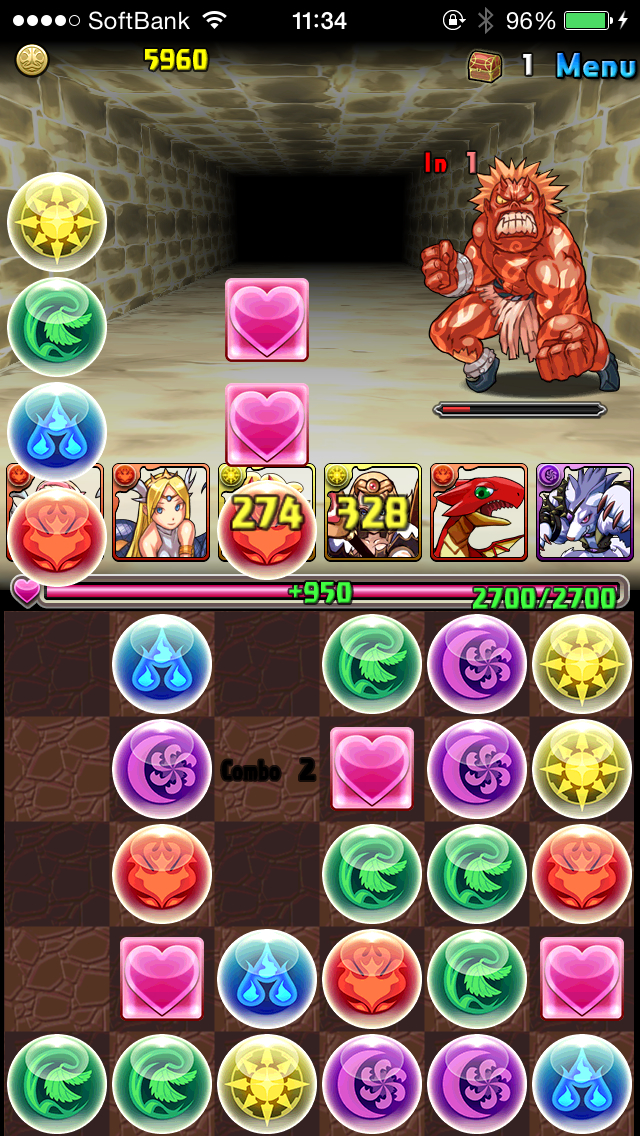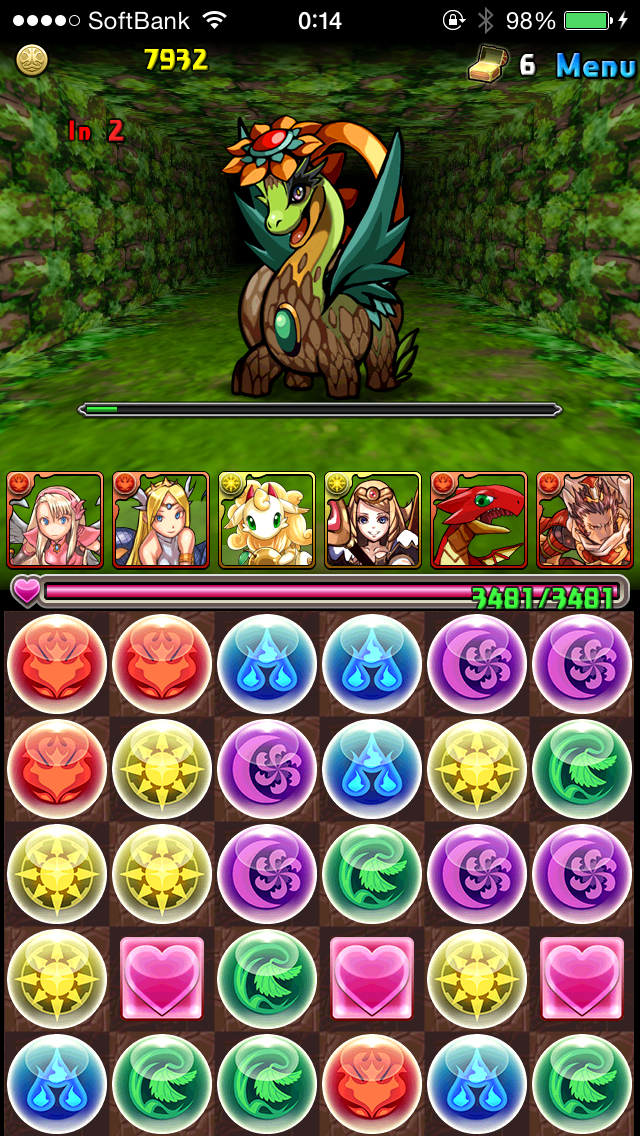 Hello, gentle readers, and welcome to the RPG Reload, the weekly feature where we try not to blow our weekly allowance on Magic Stones. Each week, we take a look at an RPG from the App Store’s past to see how it holds up in the modern day. It’s a chance to revisit, reflect, or simply take a deeper dive than our reviews typically allow. The RPG genre is impossibly broad, and I try to do my best to balance things out from week to week, but if you’ve got a game you’d like to see me play, please let me know. You can comment below, post in the Official RPG Reload Club thread in the forums, or tweet me at @RPGReload with your suggestions. The last regular reader’s choice article is coming up soon, and with the way the votes have gone, it’s all but decided. That said, I’ll still be taking anything you kind folks throw at me under advisement for future features, so feel free to speak up.
Hello, gentle readers, and welcome to the RPG Reload, the weekly feature where we try not to blow our weekly allowance on Magic Stones. Each week, we take a look at an RPG from the App Store’s past to see how it holds up in the modern day. It’s a chance to revisit, reflect, or simply take a deeper dive than our reviews typically allow. The RPG genre is impossibly broad, and I try to do my best to balance things out from week to week, but if you’ve got a game you’d like to see me play, please let me know. You can comment below, post in the Official RPG Reload Club thread in the forums, or tweet me at @RPGReload with your suggestions. The last regular reader’s choice article is coming up soon, and with the way the votes have gone, it’s all but decided. That said, I’ll still be taking anything you kind folks throw at me under advisement for future features, so feel free to speak up.
Well, it’s safe to say that this week’s entry might not be exactly what the usual crowd is here for. Puzzle & Dragons (Free) is not a normal type of RPG, if such a thing could be properly defined in the first place. In a way, it’s the boiled down essence of a couple of JRPG staples. There’s no doubt of its significance to the genre, as it signaled a major sea change in Japan’s game market and set down a template almost every RPG developer has taken a crack at. It took publisher GungHo from a relatively small-potatoes company to one of the biggest in the Japanese games industry in a matter of months, at one point even passing Nintendo’s market cap. I mean, it’s even had an official collaboration with one of gaming’s biggest stars, Mario. How many other RPG franchises can say that? (Three. The answer is ‘three’.)
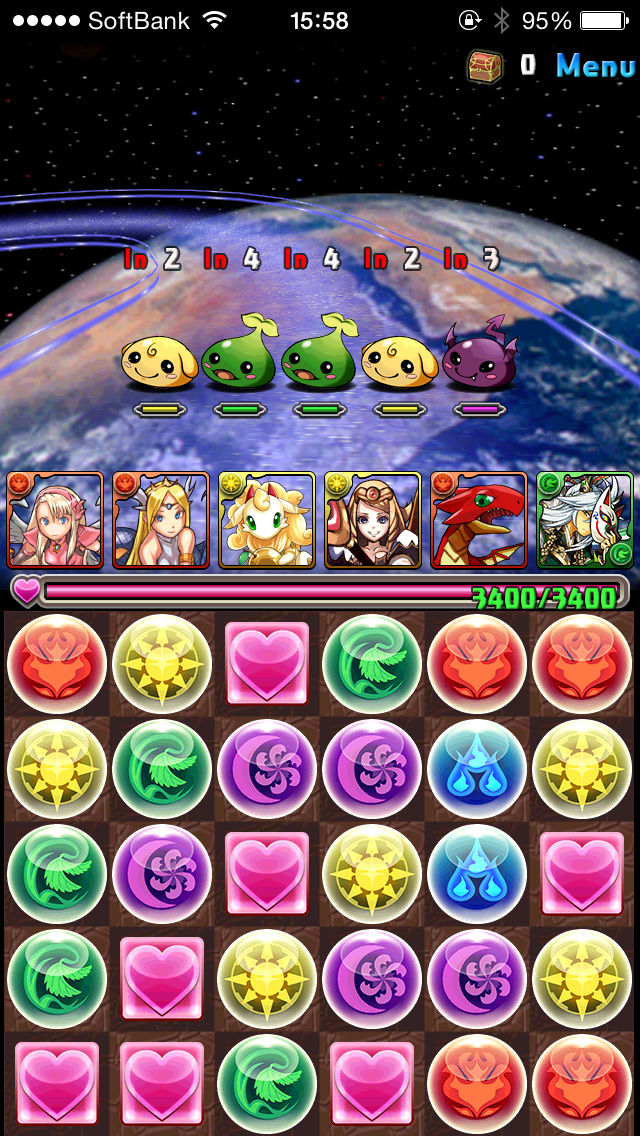 At this point in time, the game is able to succeed off of its own back, but what got it to the top in the first place? There are a lot of things going on in Puzzle & Dragons‘s design, but fundamentally, both of its major gameplay systems are a lot of fun to play with. GungHo came up with a clever hook for the matching component, creating a fast-paced take on match-3 that combines strategy, quick reflexes, and a bit of abstract thinking. There’s definitely a strong mastery involved beyond simply seeing the best matches. The other strong point of the game is in its focus on team-building, forcing the player to think carefully about how different components will work with one another. I’ll go into both of these things a bit deeper later on in the article, though. Let’s talk about the game’s history, or at least as much as we know.
At this point in time, the game is able to succeed off of its own back, but what got it to the top in the first place? There are a lot of things going on in Puzzle & Dragons‘s design, but fundamentally, both of its major gameplay systems are a lot of fun to play with. GungHo came up with a clever hook for the matching component, creating a fast-paced take on match-3 that combines strategy, quick reflexes, and a bit of abstract thinking. There’s definitely a strong mastery involved beyond simply seeing the best matches. The other strong point of the game is in its focus on team-building, forcing the player to think carefully about how different components will work with one another. I’ll go into both of these things a bit deeper later on in the article, though. Let’s talk about the game’s history, or at least as much as we know.
GungHo started its life in 1998 as ONSale Co, Ltd., an online auction business founded jointly by Japanese mobile company Softbank and the now-defunct American company onSale Inc. They made their move into games in 2002, choosing to focus on online games. Initially, the company only ran the Japanese servers for Gravity’s Ragnarok Online, but they soon entered a partnership to develop games with long-time developers Game Arts, best known for RPGs like Lunar and Grandia. The fruits of this partnership included the PSP remake of the first Lunar and the PlayStation Vita online RPG Ragnarok Odyssey. GungHo eventually acquired Gravity, with Ragnarok Online in its various forms proving to be their best success for many years. Finally, nearly 10 years later, GungHo would finally best Ragnarok‘s achievements, and with a completely homegrown hit, at that.
 The CEO of GungHo, Kazuki Morishita, is not like most CEOs of game companies. He’s a big fan of games himself, and he gets involved in the creative processes at the company he runs. Like many gamers, he has own views on the overall spectrum that makes up gaming, and in the case of mobile, Morishita firmly believes it’s the best platform for short, fast food-style games. At the same time, he’s not the sort of developer who focuses on trying to create a product with an eye for maximizing profits. He wants his company to make quality games that are fun to play, and trusts that the market won’t let him down. So yes, you can call him a pretty lucky fellow. Puzzle & Dragons entered development in August of 2011, with a young and relatively inexperienced man named Daisuke Yamamoto leading the project. By this point, the Japanese App Store charts were dominated by card games, so naturally Morishita wanted his company to produce one. According to an interview with Dean Takahashi at VentureBeat, Morishita felt that most of the games of that style were “crap", and didn’t understand why they were so successful.
The CEO of GungHo, Kazuki Morishita, is not like most CEOs of game companies. He’s a big fan of games himself, and he gets involved in the creative processes at the company he runs. Like many gamers, he has own views on the overall spectrum that makes up gaming, and in the case of mobile, Morishita firmly believes it’s the best platform for short, fast food-style games. At the same time, he’s not the sort of developer who focuses on trying to create a product with an eye for maximizing profits. He wants his company to make quality games that are fun to play, and trusts that the market won’t let him down. So yes, you can call him a pretty lucky fellow. Puzzle & Dragons entered development in August of 2011, with a young and relatively inexperienced man named Daisuke Yamamoto leading the project. By this point, the Japanese App Store charts were dominated by card games, so naturally Morishita wanted his company to produce one. According to an interview with Dean Takahashi at VentureBeat, Morishita felt that most of the games of that style were “crap", and didn’t understand why they were so successful.
Those who have played games like the ones Morishita was tallking about may have felt the same. Those games were definitely focused on the collection aspect, with little in the way of meaningful gameplay. Morishita saw an opportunity here to really shake things up with an innovative game that kept most of the strengths of the genre while addressing the major failings. Development on Puzzle & Dragons was handled by a small team of under 10 people in less than a half year. Music for the game was created in part by Kenji Ito, best known for his work on Square Enix’s Mana series. The game released in Japan in February of 2012, and within a few days, it was apparent GungHo had a big hit on their hands. The game quickly entered the number one position of the top-grossing charts in the Japanese App Store, and in the last three and a half years, it’s only slipped out of that spot a few times. In the rest of the world, it hasn’t been quite as big of a success, though it has certainly fared better than most of its imitators. The game launched in the United States in November of 2012, with launches in other countries coming at staggered points afterwards.
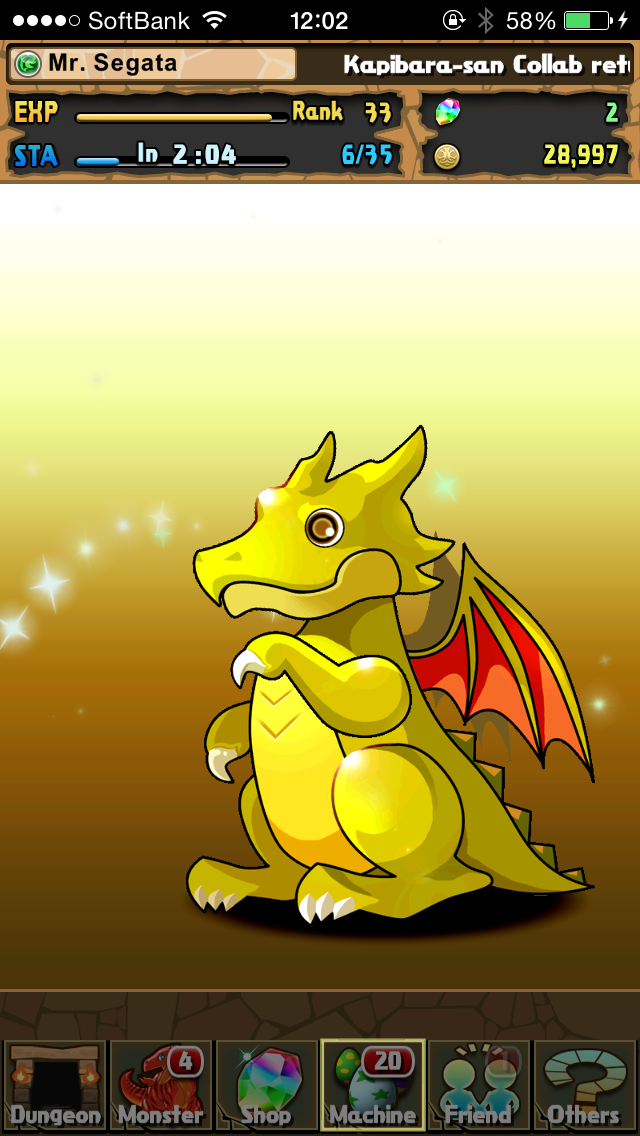 Readers who own or follow Nintendo’s 3DS are probably aware that the series made the jump to that platform as well. Though English gamers just recently got a package including both 3DS Puzzle & Dragons games, Japan had the first of those games in late 2013. True to Morishita’s beliefs, Puzzle & Dragons Z represents more of a main course serving size than the mobile original. Essentially transplanting the familiar gameplay trappings into an extremely generic JRPG template, you can almost smell GungHo’s desire to go multimedia with their hit the way Pokemon or Yo-Kai Watch did, but so far little has happened in that regard. Although Puzzle & Dragons Z was a pretty big success, the second 3DS game opted to focus on the core gameplay, creating a stage-based romp featuring Super Mario Bros. characters, items, and worlds. In addition to those titles, Japan has also seen a few mobile spin-offs, an arcade machine, and a trading card game. There is also quite a lot of branded merchandise available in Japan, naturally.
Readers who own or follow Nintendo’s 3DS are probably aware that the series made the jump to that platform as well. Though English gamers just recently got a package including both 3DS Puzzle & Dragons games, Japan had the first of those games in late 2013. True to Morishita’s beliefs, Puzzle & Dragons Z represents more of a main course serving size than the mobile original. Essentially transplanting the familiar gameplay trappings into an extremely generic JRPG template, you can almost smell GungHo’s desire to go multimedia with their hit the way Pokemon or Yo-Kai Watch did, but so far little has happened in that regard. Although Puzzle & Dragons Z was a pretty big success, the second 3DS game opted to focus on the core gameplay, creating a stage-based romp featuring Super Mario Bros. characters, items, and worlds. In addition to those titles, Japan has also seen a few mobile spin-offs, an arcade machine, and a trading card game. There is also quite a lot of branded merchandise available in Japan, naturally.
That all explains why Puzzle & Dragons is an important game in the business sense, but it doesn’t say much about how it is as a game. I’m a pretty big fan of Puzzle & Dragons, and my hope is that I’m going to be able to explain why adequately here. The game has a mixed reputation among gamers in general. It was used as an example of coercive monetization in a Gamasutra article written by Ramin Shokrizade, being cited specifically for its use of reward removal to encourage monetization. In P&D, you earn rewards while working through dungeons. If you fall in battle, the game asks you if you’d like to use premium currency to continue, warning you that if you don’t, you will lose all of the items earned in that particular run. There’s no question that the game has some very effective monetization hooks. You don’t bring in that kind of money with a free-to-play game otherwise. But I don’t think it’s an especially terrible example of a free-to-play model. In fact, I think its relative generosity compared to its contemporaries is one of the ways it has been able to dominate as strongly as it has. As a friend of mine put it, Puzzle & Dragons is not a money game disguised as a skill game, but rather a skill game that can be played as a money game.
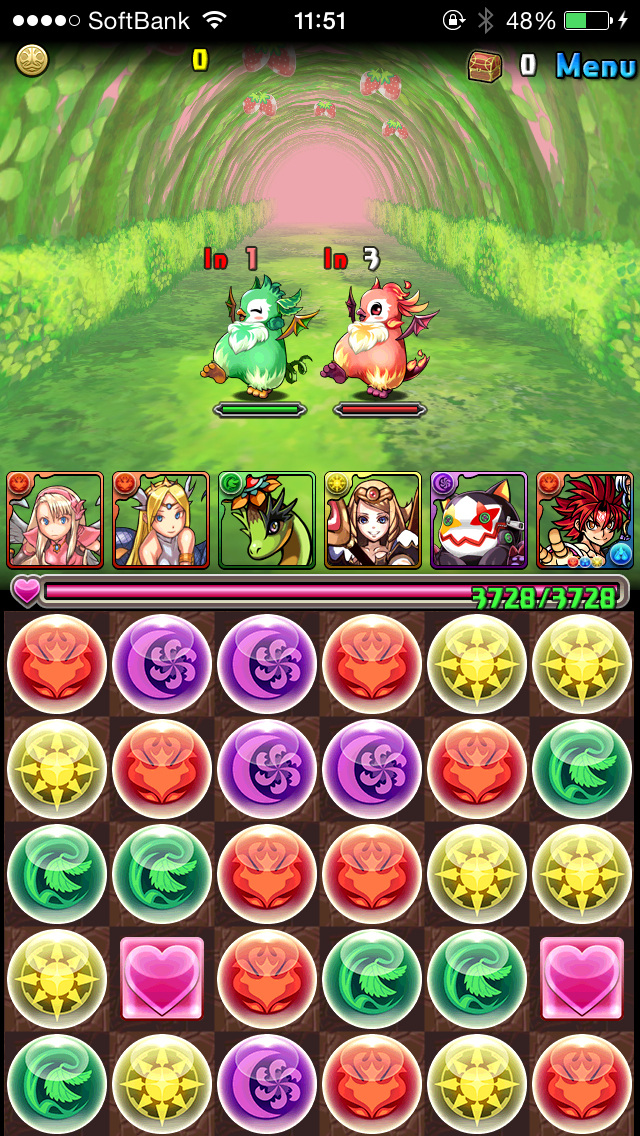 As discussed earlier in the article, there are two main components to the gameplay of Puzzle & Dragons. The puzzle side of the game isn’t extremely relevant to RPG discussion, but it is a pretty clever stand-in for a battle system, and its set-up is inextricably tied to the meatier RPG bits. The game is broken up into stages of increasing difficulty which simulate a dungeon crawl. Every few automated steps, you’ll face off against a group of monsters pulled from a pool of possibilities for that stage. As in just about any RPG, these monsters have their own stats, skills, and behaviors that you’ll want to learn. Most of them carry an element which is strong against one type and weak against another. Generally, they’re helpfully color-coded according to these elements, giving you a big hint as to which attacks you’ll need to use to maximize damage.
As discussed earlier in the article, there are two main components to the gameplay of Puzzle & Dragons. The puzzle side of the game isn’t extremely relevant to RPG discussion, but it is a pretty clever stand-in for a battle system, and its set-up is inextricably tied to the meatier RPG bits. The game is broken up into stages of increasing difficulty which simulate a dungeon crawl. Every few automated steps, you’ll face off against a group of monsters pulled from a pool of possibilities for that stage. As in just about any RPG, these monsters have their own stats, skills, and behaviors that you’ll want to learn. Most of them carry an element which is strong against one type and weak against another. Generally, they’re helpfully color-coded according to these elements, giving you a big hint as to which attacks you’ll need to use to maximize damage.
That brings us to how you attack, and the way the puzzle gameplay works. The gameplay area is a field of colored pieces corresponding to each of the elements, along with heart pieces used for healing. Each turn, you can move one piece around for a limited amount of time. As you move the piece, it will push other pieces, and the goal is to make as many matches as possible. Each match you make will cause any of your team members with corresponding elements to deal some damage. Bigger matches will do area attacks, and you can stack matches of the same element to boost the damage dealt. You can target specific enemies or just let the game choose which one you’ll hit. The enemies will fight back, of course. A number on the enemy sprite will indicate how many turns you can take before they’ll attack you next. The key to the enjoyment of this part of the game is in the pushing mechanic. When you first start playing, you’ll probably just shoot for one or two matches at a time, but experts can easily clear most of the field in a single turn. It’s a system that rewards mastery and requires a fair bit of planning and dexterity.
 On top of that, each of your team members has a special move that works on a cool down. After a certain number of turns, you can use that ability whenever you’d like. Knowing when and where to use these abilities is the key to success as the difficulty rises. Even more importantly, however, is building a team with complementary skills and elements. This is where the chewy, gooey RPG bits enter the fray. Similar to many collectible card games, you’ll be able to spot a rookie Puzzle & Dragons player by their charmingly diverse squad. They might have each element represented, and are probably fielding the strongest characters they can within their allowable limits. Now, I’m not saying that you won’t sometimes want a diverse team, but generally speaking, you’ll want to build your team for the conditions you’ll be facing, and that means bringing along a water character to a water dungeon is completely foolish. Unlike most collectible card games, however, you don’t control your resources. The pieces on the field will always cover most of the spectrum, if not all of it, and if you don’t have any team members representing an element, any matches with those pieces will do nothing. I think this is why most early players want to have one of each type.
On top of that, each of your team members has a special move that works on a cool down. After a certain number of turns, you can use that ability whenever you’d like. Knowing when and where to use these abilities is the key to success as the difficulty rises. Even more importantly, however, is building a team with complementary skills and elements. This is where the chewy, gooey RPG bits enter the fray. Similar to many collectible card games, you’ll be able to spot a rookie Puzzle & Dragons player by their charmingly diverse squad. They might have each element represented, and are probably fielding the strongest characters they can within their allowable limits. Now, I’m not saying that you won’t sometimes want a diverse team, but generally speaking, you’ll want to build your team for the conditions you’ll be facing, and that means bringing along a water character to a water dungeon is completely foolish. Unlike most collectible card games, however, you don’t control your resources. The pieces on the field will always cover most of the spectrum, if not all of it, and if you don’t have any team members representing an element, any matches with those pieces will do nothing. I think this is why most early players want to have one of each type.
Once you start getting your hands dirty with proper team-building, you’ll probably notice what you could be doing better. Many of the characters have skills that allow you to change pieces from one element to another. Clever combinations can change nearly the entire board into a single color, and if that color matches most (or all) of your team, you’re going to be raining hot death on your foes. This is just one strategy to keep in mind while you’re assembling your squad, mind you. This is where Puzzle & Dragons earns its RPG chops. The other day, I was talking with a TouchArcade forum member about the differences between western RPGs and Japanese RPGs. Off the cuff, I mentioned how WRPGs seem to be wide yet shallow, while JRPGs tend to be deep yet narrow, and I think that Puzzle & Dragons might be a perfect example of that. The game laser-focuses on the joy of building and developing a well-coordinated, highly customized group. For their part, the stages are consistent in the types of enemies you’ll face and the boss waiting at the end. That means that even if you fail the first time, you’ll have all the information you’ll need to win the second time. You just need to keep the right tools on hand to build your death squad.
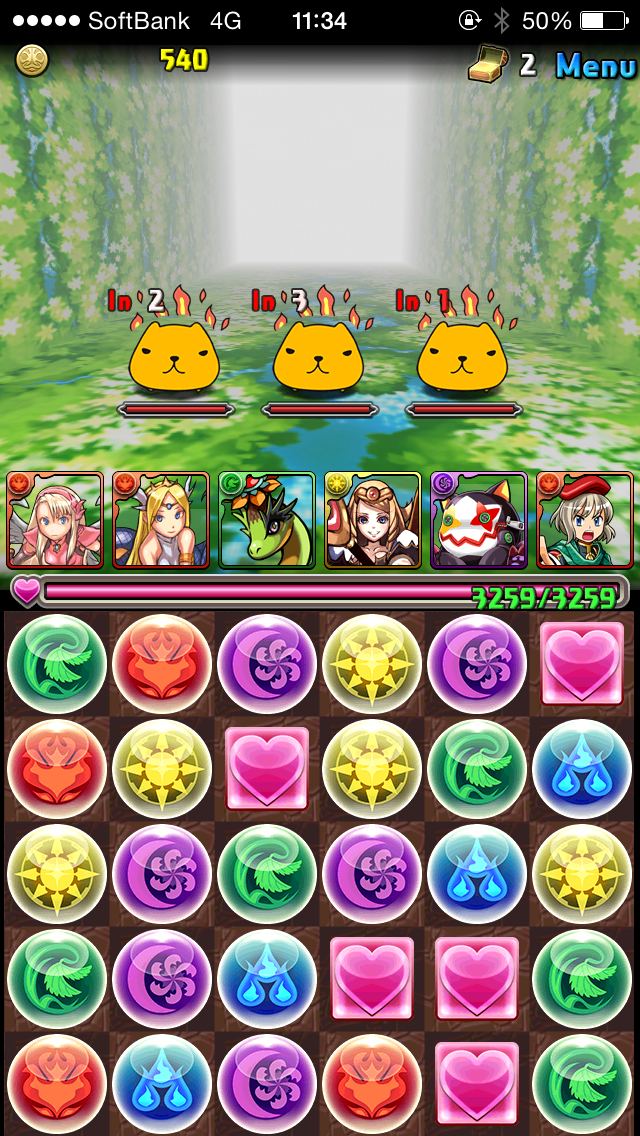 As for those tools, this is one of the places where you’re either at the mercy of luck or hard work. You’ll earn new characters in two different ways. One route is through drops during the stages. When you defeat enemies, they’ll sometimes turn into an egg after they disappear. If you manage to clear the stage, you’ll get to keep those enemies and use them on your team. The other way to get new characters is by trying your luck at the gatcha draw, which comes in two different flavors. The Premium draw requires Magic Stones, the game’s premium currency, but guarantees a reasonably powerful character. The Pal draw uses Pal Points, earned by bringing another player’s leader into battle with you. You’ll rarely get anything useful in the long term from Pal draws, but it’s good for experience/evolution fodder and temporarily plugging holes in your group.
As for those tools, this is one of the places where you’re either at the mercy of luck or hard work. You’ll earn new characters in two different ways. One route is through drops during the stages. When you defeat enemies, they’ll sometimes turn into an egg after they disappear. If you manage to clear the stage, you’ll get to keep those enemies and use them on your team. The other way to get new characters is by trying your luck at the gatcha draw, which comes in two different flavors. The Premium draw requires Magic Stones, the game’s premium currency, but guarantees a reasonably powerful character. The Pal draw uses Pal Points, earned by bringing another player’s leader into battle with you. You’ll rarely get anything useful in the long term from Pal draws, but it’s good for experience/evolution fodder and temporarily plugging holes in your group.
There’s no two ways about it, you’ll eventually reach a point where you’ll need more powerful characters. Paying can give you an advantage in certain ways, but the magnitude of that advantage is kept in check in a fairly clever way. Each player has a team capacity limit based on their overall level, and each character added to the team will take up a certain number of points. Generally, the stronger the character, the more space they’ll take up. This makes it impossible for you to just stack your team with a bunch of top-tier characters until you reach a very, very high level. Provided you aren’t buying Magic Stones, you’ll need to rely on the game’s steady trickle of free Stones to give you a chance at the premium machine now and then. The main advantage to paying is increasing your chances of getting a particular desired character, but even if you don’t drop a dime, you should have a few good team anchors to build around before too long. It’ll be a long time before you can bring more than two or three of them on the same team, anyway. Plenty of time to stockpile free Magic Stones, at any rate.
 Another handy trick to make up for not inserting coins is through the game’s friend system. This is the norm for social RPGs now, but before each stage, you’ll be asked to choose an ally to bring with you from among your friends and a few other players. This will be their team leader, and they’ll bring their own bonuses and skills to your squad. So even if you aren’t lucky enough to pull a high-powered monster, as long as you find some friends that are luckier than you are, you’ll still be able to wreak havoc. I suspect this is how many kids get along, as the game is very popular among youth in Japan, few of whom I imagine are spending any real money. One more bit of resource management you need to take care of is the size of your monster box. You can only keep so many characters at a time, and with evolution materials, keeping good characters for various types of teams, and so on, it’s easy to hit the maximum. This is actually the most sensible way to spend your Magic Stones once you’ve got some decent team anchors, as a single Stone will increase your box’s capacity.
Another handy trick to make up for not inserting coins is through the game’s friend system. This is the norm for social RPGs now, but before each stage, you’ll be asked to choose an ally to bring with you from among your friends and a few other players. This will be their team leader, and they’ll bring their own bonuses and skills to your squad. So even if you aren’t lucky enough to pull a high-powered monster, as long as you find some friends that are luckier than you are, you’ll still be able to wreak havoc. I suspect this is how many kids get along, as the game is very popular among youth in Japan, few of whom I imagine are spending any real money. One more bit of resource management you need to take care of is the size of your monster box. You can only keep so many characters at a time, and with evolution materials, keeping good characters for various types of teams, and so on, it’s easy to hit the maximum. This is actually the most sensible way to spend your Magic Stones once you’ve got some decent team anchors, as a single Stone will increase your box’s capacity.
Finally, there’s the stamina system, which is probably the most annoying part of any social RPG for genre fans. While it’s pretty generous early on, with frequent level-ups topping you off and stages requiring very little stamina for each attempt, the costs rise out of proportion with your gains as you progress. This presents a bit of a risk, since it takes some time to refill that meter. Do you gamble on a harder stage, knowing you might spend all of your stamina on a losing attempt, or do you use it up tackling easier dungeons for guaranteed but minimal rewards? It’s a bit annoying, but it’s certainly in keeping with Mr. Morishita’s view of mobile gaming’s role in the greater spectrum. The odd thing is that in the 3DS games, you don’t have to contend with a stamina meter. You can play as much as you want, whenever you want. Yet somehow, I found the individual stages and battles less exciting as a result. There’s nothing really on the line, so there’s considerably less motivation to play craftily. We don’t have many examples yet of free-to-play mobile games with stamina meters moving to a paid model on non-mobile hardware, so that was an interesting and unexpected outcome for me. I’m not going to say I like stamina meters, but their presence in a game isn’t without benefits for the careful designer, I suppose.
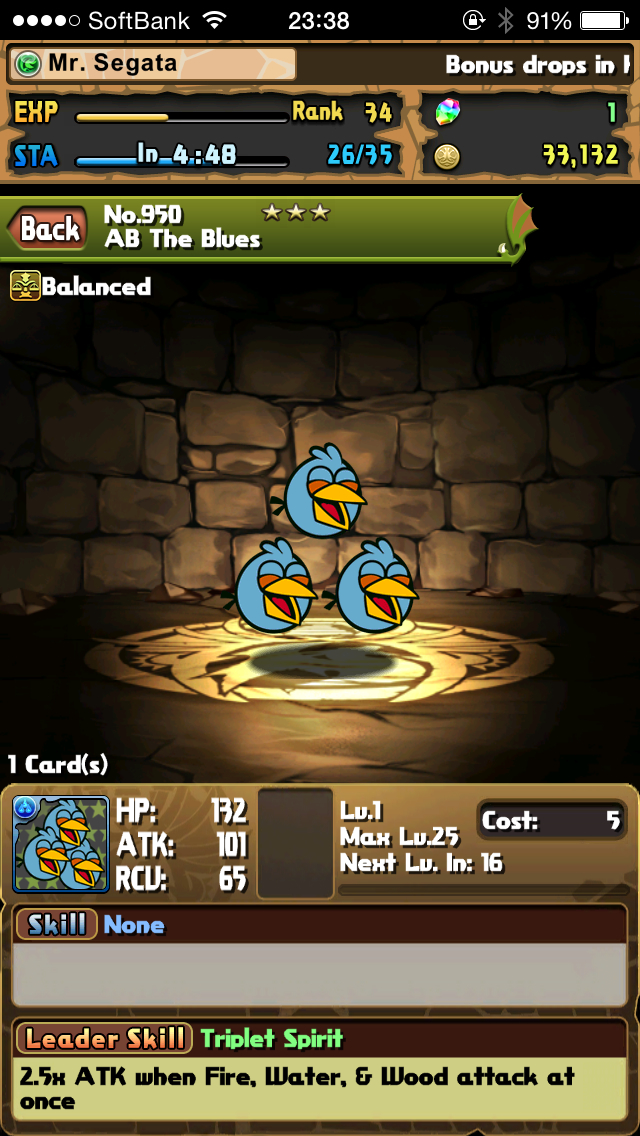 Now, as a game that essentially never ends, it’s very likely you will one day get tired of Puzzle & Dragons and stop playing it. Such is the fate of many never-ending games like social RPGs and MMOs. But by the time that happens, you’ll likely have gotten quite a bit out of it, especially if you dedicate yourself to actually learning the underlying strategy. It’s not as though I feel there’s no way to improve on the formula, but when you consider the face of social RPGs before this game, I think it’s hard to argue against Puzzle & Dragons as a net positive for players. To tell the truth, I had stopped playing long ago in favor of other games, but upon reinstalling it for this feature, it pulled me in again with its excellent mechanics and fun puzzle gameplay. In my books, that’s the mark of a pretty good game. And of course, since this is a highly profitable endless game, the updates come regularly and with interesting new content. My roster includes Batman, some Angry Birds, the Clash of Clans dude, and many other odd characters from the game’s various collaboration events. I doubt we’ll have to worry about this game being deprecated anytime soon.
Now, as a game that essentially never ends, it’s very likely you will one day get tired of Puzzle & Dragons and stop playing it. Such is the fate of many never-ending games like social RPGs and MMOs. But by the time that happens, you’ll likely have gotten quite a bit out of it, especially if you dedicate yourself to actually learning the underlying strategy. It’s not as though I feel there’s no way to improve on the formula, but when you consider the face of social RPGs before this game, I think it’s hard to argue against Puzzle & Dragons as a net positive for players. To tell the truth, I had stopped playing long ago in favor of other games, but upon reinstalling it for this feature, it pulled me in again with its excellent mechanics and fun puzzle gameplay. In my books, that’s the mark of a pretty good game. And of course, since this is a highly profitable endless game, the updates come regularly and with interesting new content. My roster includes Batman, some Angry Birds, the Clash of Clans dude, and many other odd characters from the game’s various collaboration events. I doubt we’ll have to worry about this game being deprecated anytime soon.
While it’s not everyone’s cup of tea, Puzzle & Dragons is a good, fun social RPG that stands tall among the many attempts of more established companies to follow in its footsteps. And just as Mr. Morishita seems to see it, it occupies the quick snack moments in your day quite nicely. Will I keep it on my iPhone after this article is turned in? Perhaps not. I’ve had my time with Puzzle & Dragons, and while the gameplay is still satisfying, its endless nature wears on me just as MMOs tend to after a while. It will be interesting to see how GungHo tries to follow this game up, if indeed they ever need to. While it sometimes shows signs of weakening, it’s right back up at the number one spot in Japan at the time of this writing, and I imagine it’s going to stick in that crowd for a long time to come.
That’s just my take on Puzzle & Dragons, though. What do you all think? I want to know, so please leave your thoughts in the comments below, post in the Official RPG Reload Club thread, or tweet me at @RPGReload. Also, we’re taking questions for this month’s RPG Reload Podcast. Our featured game is Final Fantasy 5 ($14.99), but you can ask about any old thing you want. Send your questions to [email protected] and we’ll try to answer them on the show. As for me, I’ll be back next week with another, slightly more traditional RPG. But only slightly. Thanks for reading!
Next Week’s Reload: DOOM 2 RPG ($0.99)
